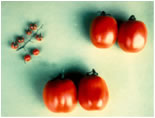

Use of wild relatives
Crop wild relatives generally have a poor phenotype from a human perspective (e.g. small fruit, low yield), but this does not mean that they carry negative alleles at all the important QTL. The presence of a "good” (i.e. positive from a breeding perspective) QTL allele can only be detected by backcrossing the wild relative with the crop, which allows the QTL to be detected (by separating the effects) in a crop genetic background. So even though the phenotype of a wild species may not look very promising, there may be hidden allelic variation for the traits you are interested in.

QTL increasing fruit size have been identified from small-fruited wild relatives of tomato (top left) and introgressed into cultivated varieties (top right), creating new lines with larger fruit (bottom row).

